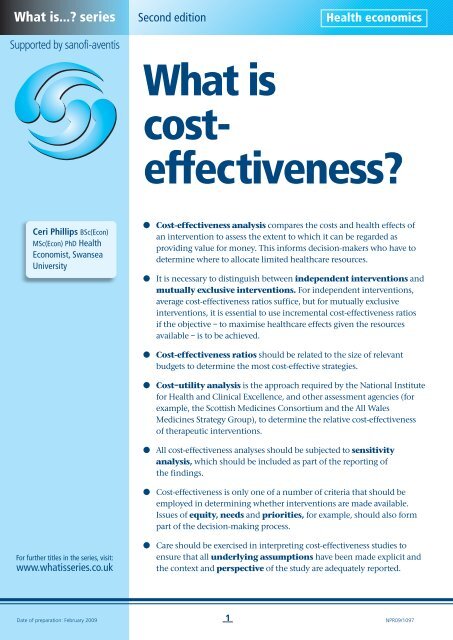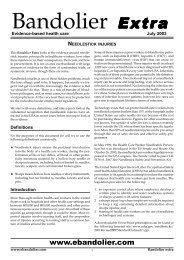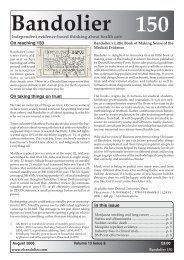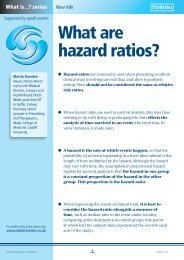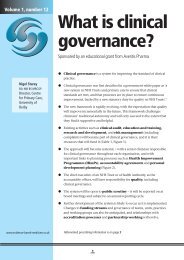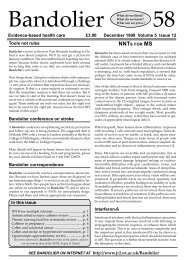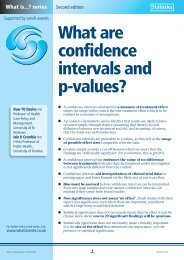What is cost- effectiveness? - Medical Sciences Division
What is cost- effectiveness? - Medical Sciences Division
What is cost- effectiveness? - Medical Sciences Division
You also want an ePaper? Increase the reach of your titles
YUMPU automatically turns print PDFs into web optimized ePapers that Google loves.
<strong>What</strong> <strong>is</strong>...? series Second edition Health economics<br />
Supported by sanofi-avent<strong>is</strong><br />
Ceri Phillips BSc(Econ)<br />
MSc(Econ) PhD Health<br />
Econom<strong>is</strong>t, Swansea<br />
University<br />
For further titles in the series, v<strong>is</strong>it:<br />
www.what<strong>is</strong>series.co.uk<br />
<strong>What</strong> <strong>is</strong><br />
<strong>cost</strong><strong>effectiveness</strong>?<br />
● Cost-<strong>effectiveness</strong> analys<strong>is</strong> compares the <strong>cost</strong>s and health effects of<br />
an intervention to assess the extent to which it can be regarded as<br />
providing value for money. Th<strong>is</strong> informs dec<strong>is</strong>ion-makers who have to<br />
determine where to allocate limited healthcare resources.<br />
● It <strong>is</strong> necessary to d<strong>is</strong>tingu<strong>is</strong>h between independent interventions and<br />
mutually exclusive interventions. For independent interventions,<br />
average <strong>cost</strong>-<strong>effectiveness</strong> ratios suffice, but for mutually exclusive<br />
interventions, it <strong>is</strong> essential to use incremental <strong>cost</strong>-<strong>effectiveness</strong> ratios<br />
if the objective – to maxim<strong>is</strong>e healthcare effects given the resources<br />
available – <strong>is</strong> to be achieved.<br />
● Cost-<strong>effectiveness</strong> ratios should be related to the size of relevant<br />
budgets to determine the most <strong>cost</strong>-effective strategies.<br />
● Cost–utility analys<strong>is</strong> <strong>is</strong> the approach required by the National Institute<br />
for Health and Clinical Excellence, and other assessment agencies (for<br />
example, the Scott<strong>is</strong>h Medicines Consortium and the All Wales<br />
Medicines Strategy Group), to determine the relative <strong>cost</strong>-<strong>effectiveness</strong><br />
of therapeutic interventions.<br />
● All <strong>cost</strong>-<strong>effectiveness</strong> analyses should be subjected to sensitivity<br />
analys<strong>is</strong>, which should be included as part of the reporting of<br />
the findings.<br />
● Cost-<strong>effectiveness</strong> <strong>is</strong> only one of a number of criteria that should be<br />
employed in determining whether interventions are made available.<br />
Issues of equity, needs and priorities, for example, should also form<br />
part of the dec<strong>is</strong>ion-making process.<br />
● Care should be exerc<strong>is</strong>ed in interpreting <strong>cost</strong>-<strong>effectiveness</strong> studies to<br />
ensure that all underlying assumptions have been made explicit and<br />
the context and perspective of the study are adequately reported.<br />
Date of preparation: February 2009 NPR09/1097<br />
1
<strong>What</strong> <strong>is</strong><br />
<strong>cost</strong>-<strong>effectiveness</strong>?<br />
<strong>What</strong> <strong>is</strong> <strong>cost</strong>-<strong>effectiveness</strong> analys<strong>is</strong>?<br />
The term <strong>cost</strong>-<strong>effectiveness</strong> has become<br />
synonymous with health economic<br />
evaluation and has been used (and m<strong>is</strong>used)<br />
to depict the extent to which interventions<br />
measure up to what can be considered to<br />
represent value for money. Strictly speaking,<br />
however, <strong>cost</strong>-<strong>effectiveness</strong> analys<strong>is</strong> <strong>is</strong> one<br />
of a number of techniques of economic<br />
evaluation, where the choice of technique<br />
depends on the nature of the benefits<br />
specified. Cost-<strong>effectiveness</strong> analys<strong>is</strong><br />
has been defined by the National Institute<br />
for Health and Clinical Excellence (NICE)<br />
as an economic study design in which<br />
consequences of different interventions<br />
are measured using a single outcome,<br />
usually in ‘natural’ units (for example,<br />
life-years gained, deaths avoided, heart<br />
attacks avoided or cases detected).<br />
Alternative interventions are then<br />
compared in terms of <strong>cost</strong> per unit of<br />
<strong>effectiveness</strong>. 1<br />
In <strong>cost</strong>–utility analys<strong>is</strong> the benefits are<br />
expressed as quality-adjusted life-years<br />
(QALYs) and in <strong>cost</strong>–benefit analys<strong>is</strong> in<br />
monetary terms. As with all economic<br />
evaluation techniques, the aim of <strong>cost</strong><strong>effectiveness</strong><br />
analys<strong>is</strong> <strong>is</strong> to maxim<strong>is</strong>e the level<br />
of benefits – health effects – relative to the<br />
level of resources available.<br />
<strong>What</strong> constitutes a <strong>cost</strong>?<br />
Costs are seen differently from different<br />
points of view. In economics the notion of<br />
<strong>cost</strong> <strong>is</strong> based on the value that would be<br />
gained from using resources elsewhere –<br />
referred to as the opportunity <strong>cost</strong>. In<br />
other words, resources used in one<br />
programme are not available for use in other<br />
programmes, and, as a result, the benefits<br />
that would have been derived have been<br />
sacrificed. It <strong>is</strong> usual, in practice, to assume<br />
that the price paid reflects the opportunity<br />
<strong>cost</strong>, and to adopt a pragmatic approach<br />
to <strong>cost</strong>ing and use market prices wherever<br />
possible.<br />
2<br />
In <strong>cost</strong>-<strong>effectiveness</strong> analys<strong>is</strong> it <strong>is</strong><br />
conventional to d<strong>is</strong>tingu<strong>is</strong>h between the<br />
direct <strong>cost</strong>s and indirect or productivity<br />
<strong>cost</strong>s associated with the intervention, as well<br />
as what are termed intangibles, which,<br />
although they may be difficult to quantify, are<br />
often consequences of the intervention and<br />
should be included in the <strong>cost</strong> profile.<br />
● Direct <strong>cost</strong>s: <strong>Medical</strong>: drugs; staff time;<br />
equipment. Patient: transport; out-ofpocket<br />
expenses.<br />
● Productivity <strong>cost</strong>s: production losses;<br />
other uses of time.<br />
● Intangibles: pain; suffering; adverse<br />
effects.<br />
It <strong>is</strong> essential to specify which <strong>cost</strong>s are<br />
included in a <strong>cost</strong>-<strong>effectiveness</strong> analys<strong>is</strong> and<br />
which are not, to ensure that the findings are<br />
not subject to m<strong>is</strong>interpretation.<br />
How to use <strong>cost</strong><strong>effectiveness</strong><br />
analys<strong>is</strong><br />
A d<strong>is</strong>tinction must be made between those<br />
interventions that are completely<br />
independent – that <strong>is</strong>, where the <strong>cost</strong>s and<br />
effects of one intervention are not affected by<br />
the introduction or otherw<strong>is</strong>e of other<br />
interventions – and those that are mutually<br />
exclusive – that <strong>is</strong>, where implementing one<br />
intervention means that another cannot be<br />
implemented, or where the implementation<br />
of one intervention results in changes to the<br />
<strong>cost</strong>s and effects of another.<br />
Independent programmes<br />
Using <strong>cost</strong>-<strong>effectiveness</strong> analys<strong>is</strong> with<br />
independent programmes requires that <strong>cost</strong><strong>effectiveness</strong><br />
ratios (CERs) are calculated<br />
for each programme and placed in rank order:<br />
Costs of intervention<br />
CER =<br />
Health effects produced<br />
(eg life-years gained)<br />
For example, in Table 1 there are three<br />
interventions for different patient groups, with<br />
the alternative for each of them of ‘doing<br />
Date of preparation: February 2009 NPR09/1097
nothing’. According to <strong>cost</strong>-<strong>effectiveness</strong><br />
analys<strong>is</strong>, programme Z should be given<br />
priority over X since it has a lower CER;<br />
however, in order to decide which programme<br />
to implement, the extent of resources available<br />
must be considered (Table 2).<br />
If a further programme becomes available,<br />
it should be considered on the bas<strong>is</strong> of its CER<br />
figure compared with Table 1. Resources for<br />
the new programme should be considered in<br />
the same manner as above.<br />
Mutually exclusive interventions<br />
In reality, the likelihood <strong>is</strong> that choices will<br />
have to be made between different treatment<br />
Table 1. Cost-<strong>effectiveness</strong> of three independent<br />
programmes<br />
Programme Cost (£) Health effect Cost-<strong>effectiveness</strong><br />
[C] (life-years gained) ratio [C/E] (£/life-<br />
[E] years gained)<br />
Z 150,000 1,850 81.08<br />
X 100,000 1,200 83.33<br />
Y 120,000 1,350 88.89<br />
Table 2. The extent of resources<br />
Budget available (£) Programme(s) to be implemented<br />
<strong>What</strong> <strong>is</strong><br />
<strong>cost</strong>-<strong>effectiveness</strong>?<br />
less effective are excluded. In Table 3 both<br />
P1 and P3 are followed by programmes that<br />
have increased <strong>effectiveness</strong> and reduced <strong>cost</strong>.<br />
In other words, P2 and P4 are associated with<br />
a negative ICER. P1 and P3 are therefore<br />
excluded.<br />
Having excluded P1 and P3, ICERs are<br />
recalculated for P2, P4 and P5 and are as<br />
shown in Table 4. P2 <strong>is</strong> ‘dominated’ by P4 as<br />
the latter <strong>is</strong> more effective and <strong>cost</strong>s less to<br />
produce an additional unit of effect (£57.14<br />
compared with £66.67). The dominated<br />
alternative <strong>is</strong> then excluded and the ICERs are<br />
recalculated again (Table 5).<br />
Costs [+]<br />
Excluded Cost-effective<br />
[–] Health-care<br />
effects [I]<br />
Questionable Dominant<br />
[–]<br />
Figure 1. Cost-<strong>effectiveness</strong> plane<br />
Table 5. Exclusion of dominated alternative<br />
4<br />
The process can be illustrated as shown in<br />
Figure 1. In our example, programmes P4<br />
and P5 would be in the <strong>cost</strong>-effective<br />
quadrant. In deciding between them, the<br />
size of the available budget must be brought<br />
to bear. If the available budget <strong>is</strong> £140,000,<br />
all patients should receive intervention P4,<br />
while, if the available budget <strong>is</strong> £170,000, all<br />
patients should receive the more effective<br />
P5. However, if the budget <strong>is</strong>, say, £150,000,<br />
then, since the <strong>cost</strong> difference between<br />
P4 and P5 <strong>is</strong> £30,000 and the budget<br />
surplus <strong>is</strong> £10,000, it <strong>is</strong> possible to switch<br />
one-third of patients to P5 and still remain<br />
within budget.<br />
Applications of <strong>cost</strong><strong>effectiveness</strong><br />
analys<strong>is</strong><br />
The assessment of <strong>cost</strong>-<strong>effectiveness</strong> <strong>is</strong> an<br />
essential component in determining whether<br />
a therapy <strong>is</strong> approved for reimbursement and<br />
for formulary inclusion. Health technology<br />
assessment agencies such as NICE place<br />
considerable weight on the relative <strong>cost</strong><strong>effectiveness</strong><br />
of therapies in making their<br />
judgements. NICE requires the use of<br />
<strong>cost</strong>–utility analys<strong>is</strong>, in which the outcome<br />
measure <strong>is</strong> expressed as a QALY, and which<br />
enables compar<strong>is</strong>ons to be made across<br />
therapeutic areas – using the QALY as the<br />
‘common currency’. In <strong>cost</strong>–utility analys<strong>is</strong><br />
the ICER therefore becomes the <strong>cost</strong> per QALY<br />
gained and can be compared with those of<br />
other interventions, or with a notional<br />
Table 4. Exclusion of more <strong>cost</strong>ly and less effective alternatives<br />
Programme Costs (£) Effects (life- Incremental Incremental ICER<br />
[C] years gained) [E] <strong>cost</strong> [∆C] effect [∆E] [∆C/∆E]<br />
P2 100,000 1,500 100,000 1,500 66.67<br />
P4 140,000 2,200 40,000 700 57.14<br />
P5 170,000 2,600 30,000 400 75.00<br />
Programme Costs (£) Effects (life- Incremental Incremental ICER<br />
[C] years gained) [E] <strong>cost</strong> [∆C] effect [∆E] [∆C/∆E]<br />
P4 140,000 2,200 140,000 2,200 63.64<br />
P5 170,000 2,600 30,000 400 75.00<br />
Date of preparation: February 2009 NPR09/1097
Probability <strong>cost</strong>-effective<br />
1.00 –<br />
0.80 –<br />
0.60 –<br />
0.40 –<br />
0.20 –<br />
–0.20 –<br />
threshold value of what <strong>is</strong> considered to<br />
represent <strong>cost</strong>-<strong>effectiveness</strong> (see <strong>What</strong> <strong>is</strong><br />
<strong>cost</strong>–utility analys<strong>is</strong>? 2 for further d<strong>is</strong>cussion).<br />
Cost-<strong>effectiveness</strong> analys<strong>is</strong> (or <strong>cost</strong>–utility<br />
analys<strong>is</strong>) <strong>is</strong> far from being a prec<strong>is</strong>e science,<br />
and there <strong>is</strong> often considerable uncertainty<br />
associated with the findings and wide<br />
variation around the estimate generated. For<br />
example, one of the early technology<br />
appra<strong>is</strong>als undertaken by NICE was on<br />
interferon beta and glatiramer acetate for the<br />
treatment of multiple scleros<strong>is</strong>. Estimates of<br />
the <strong>cost</strong>-<strong>effectiveness</strong> varied enormously due<br />
to differing assumptions relating to the<br />
duration of treatment, the number, severity<br />
and impact on quality of life (QoL) of relapses<br />
that occurred, and the extent to which<br />
progression was comprom<strong>is</strong>ed by the<br />
interventions.<br />
It <strong>is</strong> therefore imperative that the<br />
assessment of <strong>cost</strong>-<strong>effectiveness</strong> should be<br />
subjected to a sensitivity analys<strong>is</strong> to enable<br />
dec<strong>is</strong>ion-makers to be fully aware of the range<br />
of possible eventualities.<br />
Sensitivity analys<strong>is</strong><br />
The need for sensitivity analys<strong>is</strong> ar<strong>is</strong>es because<br />
of a number of factors. These include:<br />
● Methodological <strong>is</strong>sues ar<strong>is</strong>ing from<br />
different approaches and methods<br />
employed in the evaluation<br />
5<br />
<strong>What</strong> <strong>is</strong><br />
<strong>cost</strong>-<strong>effectiveness</strong>?<br />
– –<br />
£0 £5,000 £10,000 £15,000 £20,000 £25,000 £30,000<br />
Figure 2. Cost-<strong>effectiveness</strong> acceptability curve<br />
Value of ceiling ratio<br />
● Potential variation in the estimates of <strong>cost</strong>s<br />
and effects used in the evaluation<br />
● Extrapolation from observed events over<br />
time or from intermediate to final health<br />
outcomes<br />
● Transferability of results and the validity of<br />
results from different populations/patient<br />
groups.<br />
ICERs therefore require some indication of<br />
the confidence that can be placed in them.<br />
<strong>What</strong> would happen, for example, if the ‘true<br />
<strong>cost</strong>’ of one of the treatment strategies was<br />
somewhat higher or lower than the estimate<br />
used in the investigation, or if there were<br />
significant changes in the life-years gained or<br />
other parameters used? Sensitivity analys<strong>is</strong><br />
tests all the assumptions used in the model<br />
and enables the impact of changes on the<br />
baseline estimates to be investigated.<br />
The use of probabil<strong>is</strong>tic sensitivity analys<strong>is</strong><br />
<strong>is</strong> now recogn<strong>is</strong>ed as the appropriate format<br />
for undertaking and reporting sensitivity<br />
analys<strong>is</strong>, via a <strong>cost</strong>-<strong>effectiveness</strong> plane and<br />
acceptability curve, as shown in Figures 1<br />
and 2.<br />
These are generated by <strong>cost</strong>s and effects<br />
data being simulated repeatedly (usually<br />
1,000 times) to generate a vector of CERs,<br />
which are plotted on the <strong>cost</strong>-<strong>effectiveness</strong><br />
plane, and from which the <strong>cost</strong>-<strong>effectiveness</strong><br />
acceptability curve <strong>is</strong> derived. Th<strong>is</strong> indicates<br />
the likelihood that the CER lies below a<br />
Date of preparation: February 2009 NPR09/1097
<strong>What</strong> <strong>is</strong><br />
<strong>cost</strong>-<strong>effectiveness</strong>?<br />
Box 1. Checkl<strong>is</strong>t for assessing <strong>cost</strong>-<strong>effectiveness</strong> studies 5<br />
Study design<br />
(1) The research question <strong>is</strong> stated<br />
(2) The economic importance of the research question <strong>is</strong> stated<br />
(3) The viewpoint(s) of the analys<strong>is</strong> are clearly stated and justified<br />
(4) The rationale for choosing the alternative programmes or interventions compared <strong>is</strong> stated<br />
(5) The alternatives being compared are clearly described<br />
(6) The form of economic evaluation used <strong>is</strong> stated<br />
(7) The choice of form of economic evaluation <strong>is</strong> justified in relation to the questions addressed<br />
Data collection<br />
(8) The source(s) of <strong>effectiveness</strong> estimates used are stated<br />
(9) Details of the design and results of <strong>effectiveness</strong> study are given (if based on a single study)<br />
(10) Details of the method of synthes<strong>is</strong> or meta-analys<strong>is</strong> of estimates are given (if based on an<br />
overview of a number of <strong>effectiveness</strong> studies)<br />
(11) The primary outcome measure(s) for the economic evaluation are clearly stated<br />
(12) Methods to value health states and other benefits are stated<br />
(13 Details of the subjects from whom valuations were obtained are given<br />
(14) Productivity changes (if included) are reported separately<br />
(15) The relevance of productivity changes to the study question <strong>is</strong> d<strong>is</strong>cussed<br />
(16) Quantities of resources are reported separately from their unit <strong>cost</strong>s<br />
(17) Methods for the estimation of quantities and unit <strong>cost</strong>s are described<br />
(18) Currency and price data are recorded<br />
(19) Details of currency of price adjustments for inflation or currency conversion are given<br />
(20) Details of any model used are given<br />
(21) The choice of model used and the key parameters on which it <strong>is</strong> based are justified<br />
Analys<strong>is</strong> and interpretation of results<br />
(22) Time horizon of <strong>cost</strong>s and benefits <strong>is</strong> stated<br />
(23) The d<strong>is</strong>count rate(s) <strong>is</strong> stated<br />
(24) The choice of rate(s) <strong>is</strong> justified<br />
(25) An explanation <strong>is</strong> given if <strong>cost</strong>s or benefits are not d<strong>is</strong>counted<br />
(26) Details of stat<strong>is</strong>tical tests and confidence intervals are given for stochastic data<br />
(27) The approach to sensitivity analys<strong>is</strong> <strong>is</strong> given<br />
(28) The choice of variables for sensitivity analys<strong>is</strong> <strong>is</strong> justified<br />
(29) The ranges over which the variables are varied are stated<br />
(30) Relevant alternatives are compared<br />
(31) Incremental analys<strong>is</strong> <strong>is</strong> reported<br />
(32) Major outcomes are presented in a d<strong>is</strong>aggregated as well as aggregated form<br />
(33) The answer to the study question <strong>is</strong> given<br />
(34) Conclusions follow from the data reported<br />
(35) Conclusions are accompanied by the appropriate caveats<br />
6<br />
Date of preparation: February 2009 NPR09/1097
certain threshold (ceiling), which represents a<br />
benchmark against which to assess whether<br />
the intervention can be regarded as<br />
representing value for money. There are<br />
obviously a number of <strong>is</strong>sues that surround<br />
the use of such explicit approaches to<br />
informing what therapies are made available,<br />
many of which are contentious and<br />
controversial – see, for example, the<br />
d<strong>is</strong>cussion surrounding the NICE preliminary<br />
determination relating to therapies. 3,4<br />
Implications of <strong>cost</strong><strong>effectiveness</strong><br />
analys<strong>is</strong><br />
While <strong>cost</strong>-<strong>effectiveness</strong> analys<strong>is</strong> <strong>is</strong> a useful<br />
technique for ass<strong>is</strong>ting in the dec<strong>is</strong>ion-making<br />
process, there are important <strong>is</strong>sues to<br />
consider.<br />
● Cost-<strong>effectiveness</strong> analys<strong>is</strong> can indicate<br />
which one of a number of alternative<br />
interventions represents the best value for<br />
money, but it <strong>is</strong> not as useful when<br />
compar<strong>is</strong>ons need to be made across<br />
different areas of healthcare, since the<br />
outcome measures used may be very<br />
different. As long as the outcome measure<br />
<strong>is</strong> life-years saved or gained, compar<strong>is</strong>ons<br />
can be made, but even in such situations<br />
<strong>cost</strong>-<strong>effectiveness</strong> analys<strong>is</strong> remains<br />
insensitive to the QoL dimension. In order<br />
to know which areas of healthcare are<br />
likely to provide the greatest benefit in<br />
improving health status, a <strong>cost</strong>–utility<br />
analys<strong>is</strong> needs to be undertaken using a<br />
‘common currency’ for measuring the<br />
outcomes across healthcare areas. If<br />
information <strong>is</strong> needed as to which<br />
interventions will result in overall resource<br />
7<br />
<strong>What</strong> <strong>is</strong><br />
<strong>cost</strong>-<strong>effectiveness</strong>?<br />
savings, a <strong>cost</strong>–benefit analys<strong>is</strong> has to be<br />
done, although both <strong>cost</strong>–utility analys<strong>is</strong><br />
and <strong>cost</strong>–benefit analys<strong>is</strong> have their own<br />
drawbacks.<br />
● The quality of <strong>cost</strong>-<strong>effectiveness</strong> analyses <strong>is</strong><br />
highly dependent on the quality of<br />
<strong>effectiveness</strong> data used, and all <strong>cost</strong><strong>effectiveness</strong><br />
analyses should include a<br />
detailed sensitivity analys<strong>is</strong> to test the<br />
extent to which changes in the parameters<br />
used in the analys<strong>is</strong> may affect the results<br />
obtained. A useful checkl<strong>is</strong>t for assessing<br />
<strong>cost</strong>-<strong>effectiveness</strong> studies <strong>is</strong> to be found<br />
in Box 1. 5<br />
● Cost-<strong>effectiveness</strong> <strong>is</strong> only one of a number<br />
of criteria that should be employed in<br />
determining whether interventions are<br />
made available. Issues of equity, needs,<br />
priorities and so on should also form part<br />
of the dec<strong>is</strong>ion-making process.<br />
References<br />
1. National Institute for Health and Clinical Excellence.<br />
Guide to the methods of technology appra<strong>is</strong>al.<br />
www.nice.org.uk/media/B52/A7/TAMethodsGuideUpdat<br />
edJune2008.pdf (last accessed 31 October 2008)<br />
2. McCabe C. <strong>What</strong> <strong>is</strong> <strong>cost</strong>–utility analys<strong>is</strong>? London:<br />
Hayward <strong>Medical</strong> Communications, 2009.<br />
3. http://news.bbc.co.uk/1/hi/health/7544927.stm (last<br />
accessed 7 January 2009)<br />
4. http://news.bbc.co.uk/1/hi/health/7597952.stm (last<br />
accessed 7 January 2009)<br />
5. Drummond MF, Jefferson TO. Guidelines for authors<br />
and peer reviewers of economic subm<strong>is</strong>sions to the BMJ.<br />
The BMJ Economic Evaluation Working Party. BMJ 1996;<br />
313: 275–283.<br />
Further reading<br />
1. Drummond MF, Sculpher MJ, Torrance GW, O’Brien<br />
BJ, Stoddart GL. Methods for the Economic Evaluation of<br />
Health Care Programmes. Oxford: Oxford University Press,<br />
2005.<br />
2. Phillips CJ. Health Economics: An introduction for health<br />
professionals. Oxford: Blackwell Publ<strong>is</strong>hing, 2005.<br />
Date of preparation: February 2009 NPR09/1097
Supported by sanofi-avent<strong>is</strong><br />
8<br />
<strong>What</strong> <strong>is</strong>...? series<br />
<strong>What</strong> <strong>is</strong><br />
<strong>cost</strong>-<strong>effectiveness</strong>?<br />
First edition publ<strong>is</strong>hed 2001.<br />
Authors: Ceri Phillips and<br />
Guy Thompson<br />
Th<strong>is</strong> publication, along with<br />
the others in the series, <strong>is</strong><br />
available on the internet at<br />
www.what<strong>is</strong>series.co.uk<br />
The data, opinions and statements<br />
appearing in the article(s) herein<br />
are those of the contributor(s)<br />
concerned. Accordingly, the<br />
sponsor and publ<strong>is</strong>her, and their<br />
respective employees, officers<br />
and agents, accept no liability<br />
for the consequences of any such<br />
inaccurate or m<strong>is</strong>leading data,<br />
opinion or statement.<br />
Publ<strong>is</strong>hed by Hayward <strong>Medical</strong><br />
Communications, a div<strong>is</strong>ion of<br />
Hayward Group Ltd.<br />
Copyright © 2009 Hayward<br />
Group Ltd.<br />
All rights reserved.<br />
Date of preparation: February 2009 NPR09/1097


